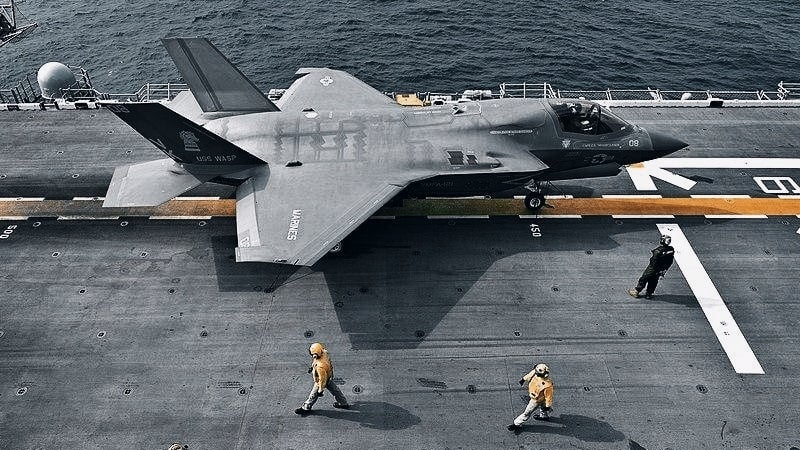Pars Today's Iran and world news package
Can Yemeni defense system be a threat to American F-35 Jets?
-

Can Yemeni defense system be a threat to American F-35 Jets?
Pars Today - The United States has started widespread aerial attacks against Yemen since 15 March, 2025 which has been the greatest American military operation in West Asia since the second term of President Donald Trump.
The US navy and air force have struck different regions of Yemen more than 1000 times. According to Pars Today, in these attacks, Americans have used strike fighters deployed on "Harry Truman" and "Carl Vinson" aircraft-carriers.
The US even used the strategic B-2 bombers and the 14-ton "BU-57" bunker buster bombs in these attacks. However, these bombs were not successful against the Yemeni underground targets and Yemenis managed to rebuild the entrance and exit to the tunnels hit by these bombs. Thus, these munitions failed to yield the expected results and Americans understood that they have a very tough job to destroy the military capability of Yemenis.
Continuation of failures and the rise in the US military loss, including downing of several F-18 jets and tens of drones, coupled with the possibility of hitting the advanced F-35 fighters by Yemen, forced the White House to sudden change of its stance and announcement of ceasefire with Yemen.
The US President, Donald Trump, stopped military operation against Yemen on 8 May. NBC News reported that this operation has cost over $1 billion for the US since March, including thousands of bombs and missiles dropped on Yemen.
New York Times, in an article titled, "Why Trump Suddenly Declared Victory Over Houthi Militia" pointed to the causes of sudden stopping of US attacks against Yemen. According to the article, Trump's primary imagination was that he could gain his expected results within one month. But, after spending more than $1 billion and losing a number of F-18 Super Hornet strike fighters and the highly propagated MQ-9 UAVs, Trump lost his patience.
Another part of this report says that the Yemeni defense systems had nearly hit the American "sophisticated" F-16 and F-35 fighter jets, thus, Trump decided to halt attacks against Yemen to prevent further scandal. Through the Omani mediation, the US asked Yemen to stop striking American ships so that the American military would also stop attacking Yemen.
Now the question is: What defense systems and missiles have the Yemenis used against the American aggressive fighters so that Trump has been so much scared? Yemenis unveiled their Fater-1 defense missiles in late August, 2019. This missile is apparently a new version of 3M9 missile which was among the SAM-6 (surface-to-air) air defense system of the Soviet era with a range of 25 kilometers. This is a medium range defense system with a likely semi-active radar and infrared guidance which has been able to down the American MQ-9 drone.
Yemenis, also, succeeded to down a number of the Saudi warplanes such as F-15, Tornado and Apache helicopters during the Saudi coalition war, with innovative prowess in turning the short-range R-27 air-to-air missiles equipped with the Russian infrared guidance system.
The images of downing these kinds of aircraft indicate that Yemenis had first detected the target with thermal cameras, and then shot the missile having thermal (infrared) head towards the targeted aircraft. According to the flight profile and explosion power, the released images indicate the usage of short-range R-27 missiles.
F-35 fighter jet is a stealth (radar-evasive) type aircraft which provides it high protection and immunity against air defense systems. Yet, the short-range defense systems equipped with guided infrared missiles, such as R-27, are capable of visual detection of this fighter and shooting towards it; hence, they seriously threaten stealth fighters and the G-4 fighters of F-16.
In view of this, an American official acknowledged in an interview with War Zone website, that in order to escape the Yemeni surface (ground)-to-air Yemeni missiles, the F-35 fighter had to do evasion maneuvers. He said, "The missiles were so close that F-35 was forced to conduct maneuver." Some other American officials also said, "Several F-16 and F-35 fighters had nearly been hit with the Yemeni air defense system and this caused the possibility of American losses quite real."
Therefore, the innovations that Yemenis use in arms and munitions are among the causes to force the US to reconsider military operation against Yemen and finally decide to stop these attacks. In fact, the United States had underestimated the professional Yemeni forces and Ansraullah combatants who enjoy long experience of fighting Saudi coalition, although the Western false and biased depiction of them had entrapped the American officials and military commanders in the wishful thinking of confronting a primitive and unskilled people who lack primary military prowess.
The outcome of the American military operation against Yemen, including 27 MQ-9 "Reaper" drones shot down with Yemeni missiles, cost over $800 million for Washington. Moreover, the serious risk for F-35 fighters' downing proved that Yemeni combatants enjoy indescribable valor, knowhow and skills in addition to military equipment which have enabled them to deal effective and painful blows to the US and horrify them.
RM/MG


